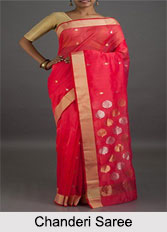 A long heritage of tradition continues to add a highly distinctive, individualistic touch to the crafts of Madhya Pradesh. Located in center of India, Madhya Pradesh is home to Hand Block Printing, Tie and Dye, Batik and Weaving of fabrics. Madhya Pradesh is also famous for its delicate weaves in Chanderi and Maheshwari sarees. The wonderful creations of the craftsmen and the diverse art forms of Madhya Pradesh have survived innumerable centuries.
A long heritage of tradition continues to add a highly distinctive, individualistic touch to the crafts of Madhya Pradesh. Located in center of India, Madhya Pradesh is home to Hand Block Printing, Tie and Dye, Batik and Weaving of fabrics. Madhya Pradesh is also famous for its delicate weaves in Chanderi and Maheshwari sarees. The wonderful creations of the craftsmen and the diverse art forms of Madhya Pradesh have survived innumerable centuries.

•Bandhni Saree: Madhya Pradesh is also home to the art of tying and dyeing of fabric which is popularly known as Bandhni. This delicate technique represents the earliest forms of resist patterning. In this process, parts of the fabric are tied with thread or twined into minute knots and then dipped in dye.
•Batik Saree: Another form of fabric printing is Batik. Batik is a resist process in which the fabric is painted with molten wax and then dyed in cold dyes. Batik is done on a large scale in Indore and Bherongarh. Multi-coloured and variously designed Batik sarees are popular and attractive for their contrast colour schemes.

•Chanderi Saree: Silk is used as the warp and cotton for the weft to produce the famous Chanderi sarees. The Chanderi cotton sarees are ideal summer wear. Usually in subtle hues, they have a sophistication that is hard to match. In the silk "Zari" sarees, craft influences of the Varanasi style are visible. The sarees generally have a rich gold border and two gold bands on the pallu. The more expensive sarees have gold checks with lotus roundels all over which are known as butis.
•Maheshwari Saree: The town of Maheshwar in Madhya Pradesh is famous for its Maheshwari saree. The Maheshwari saree, mostly in cotton and silk, is characterised by its simplicity. The body is either chequered, plain or has stripes, combined with complementary colours. The reversible border of the saree which can be worn either side, is a specialty. It has a variety of leaves and flowers on the border and is quite popular. The pallu of Maheshwari sari is also distinctive with 5 stripes, 3 colored and 2 white alternating.
•Tussar Silk Saris: Madhya Pradesh is also known for its Tussar silk or Kosa silk as it is known here. Rajgarh and Champa are important centres for Tussar silk sarees and fabrics. These sarees radiate a natural brilliance - the pallus and borders of the sarees are woven with thread, coloured in the Ikat style to give it a designer touch.





















